Parameters of Flight

Roseate skimmer. More detail is in the large view (click on the magnifying glass).
Above the pond, above the trees, in orbit....
The water in the "post office pond" slowly recedes. The spillway begins to dry, and what is left becomes thick and murky.
On the summer solstice it was thick with Odonata -- the order that includes both dragonflies and damselflies. Rainbow colors: orange Eastern Amberwings, orange and black Halloween Pennants, bright Blue Dashers and Atlantic Bluets -- and pink dragonflies that made my eyes widen.
Those were the Roseate Skimmers, Orthemis ferruginea, Family Libellulidae (Common Skimmers). According to eNature.com, "Often the male does not attain full color until a few days after emergence. The short, squat naiads, to 1 1/4" (33 mm) long, inhabit shallower, warmer waters than naiads of other families and tend to be more active, maturing more rapidly."
Before I'd seen the skimmers I came upon a quartet of White Ibises -- three adults and one still-dark-feathered juvenile. That made me revise my "kiddie pool" assumption. Prior to the solstice I'd seen young juveniles only at the "library pond."

Very slowly I made my way down the rise, toward the spillway. I averted my gaze, glancing back in the birds' direction every so often, making sure they remained unperturbed by my presence. When Mary is with me we keep closer to the road. But I figured that if I could habituate a wild hare and a moose to my presence (chronicled in "Hare's Grove" and in "The Unexpected Trails"), maybe I could do so with the ibises.
Near the water I sat on a dried lip of spillway and watched as the young bird attended to its personal hygiene.
Bird Bath (0:47)
One of the adults seems to be offering a flying lesson here, but the juvenile already knows quite well how it's done.
Flying Lesson (0:39)
Ibis in Flight (0:19)
I thought another ibis was lingering at the far end of the pond. Instead, it was a Great Egret.
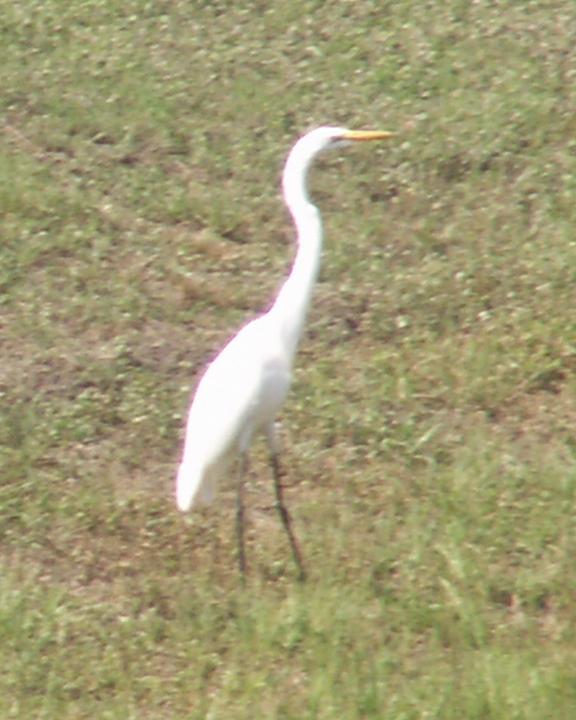
Great Egret in Flight (0:41)
(Back on Monday, after recording a video of lightning (0:29) from the banks of the pond, I had followed the antics of a flock of about 20 ibises on a neighbor's lawn. They star in "Ibis Convention, Part 1" (2:46) and "Ibis Convention, Part 2" (2:59), divided into two segments due to uploading space constraints.)
Once the birds had gone I ventured to the water's edge, moving slowly among the dragonflies. The temperature was around 95 degrees, the heat index about 102. It still amazes me that the heat and humidity doesn't bother me as much as it rightfully should. The secret of living here is to embrace one's sweat.
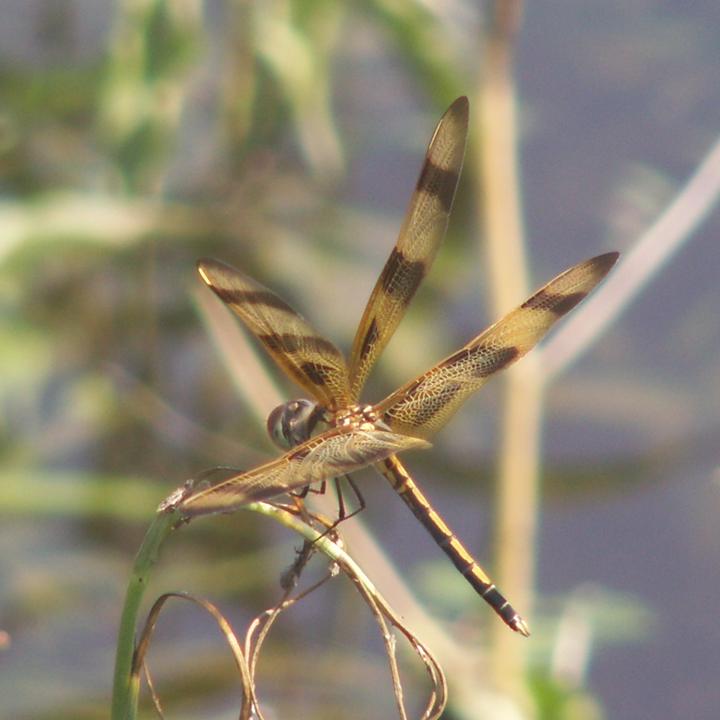
Halloween Pennant, Celithemis eponina, Family Libellulidae (Common Skimmers). Also called a Brown-Spotted Yellow Wing. Ranges throughout eastern North America, year-round in Florida. "Predatory on other insects," says Bugguide.Net. "Males are not territorial, perch near edge of ponds, waiting for incoming females. Mating typically takes place in the morning. Oviposition is in tandem. Frequently seen perched on weeds in fields as it forages, pivoting with the wind."
Based on this one's behavior (perched on weeds by the pond) and the photo posted at Bob Moul's nature photography site, I'm guessing it's a male.
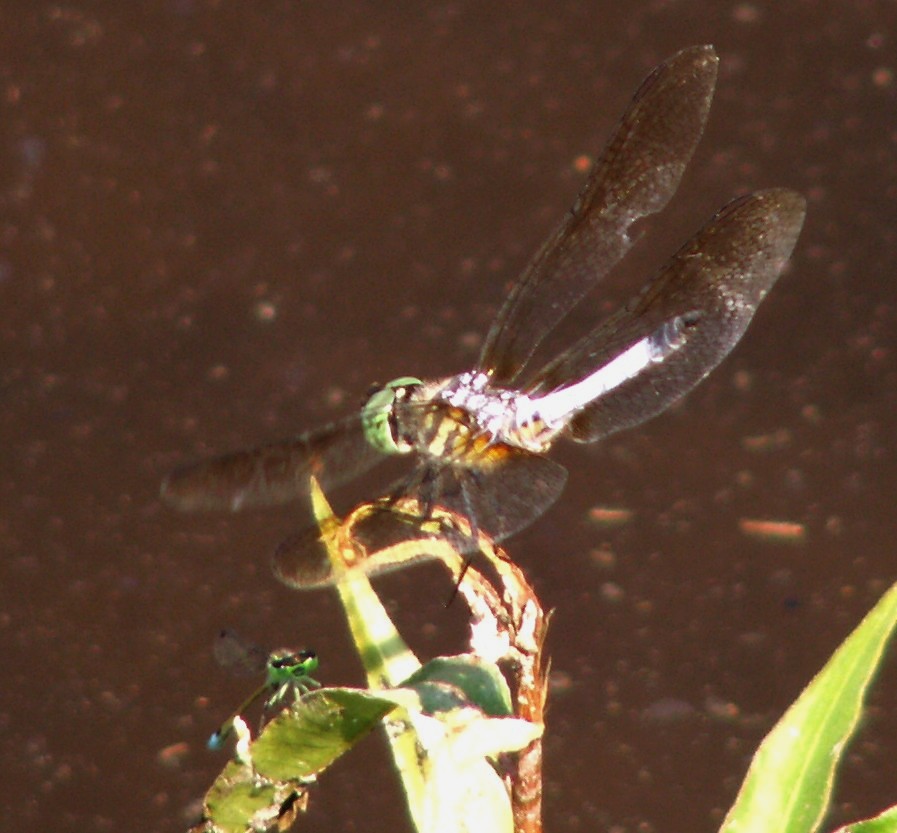
Here a male Blue Dasher dragonfly (Pachydiplax longipennis) faces off against a male Atlantic Bluet damselfly (Enallagma doubledayi, below and slightly to the left of the dasher).
At around 4 AM yesterday, shortly before our morning paper was delivered, Mary knocked on my studio door (I hadn't yet gone to bed) and said, "You've got to come see the Milky Way."
My first conscious memory of the Milky Way dates from 1979, though I had probably first seen it in 1972. When I graduated from my K-8 elementary school, my parents had given me a small refractor telescope. My chief memories of the telescope come from nights spent in Brooklyn, on the porch outside my grandmother's room while she wintered in Florida. But I had also brought the telescope to the Gilcrest Motel in New Hampshire's White Mountains, where my parents and I vacationed during the summer and to which I returned in "The Unexpected Trails". Up there, the scope was useless to me -- there were simply too many stars in the sky for me to find any familiar reference points. The Summer Triangle would have been up, and therefore the Milky Way slicing through it, but I have no memory of that.
Instead, my first Milky Way memory occurs on the shore of the Pacific Ocean, I think in Santa Barbara, in August of 1979. I'd been on my honeymoon (I left the marriage 3-1/2 years later) and on my first trip to California. The Milky Way hung above phosphorescent surf, bright enough for me to see its Great Rift.
It was bright enough for me to see the Great Rift here, too, yesterday morning, as Mary and I stood on our driveway. Soon a waning crescent moon three days short of New (12% of full) glowed from behind trees, then gradually rose above them.
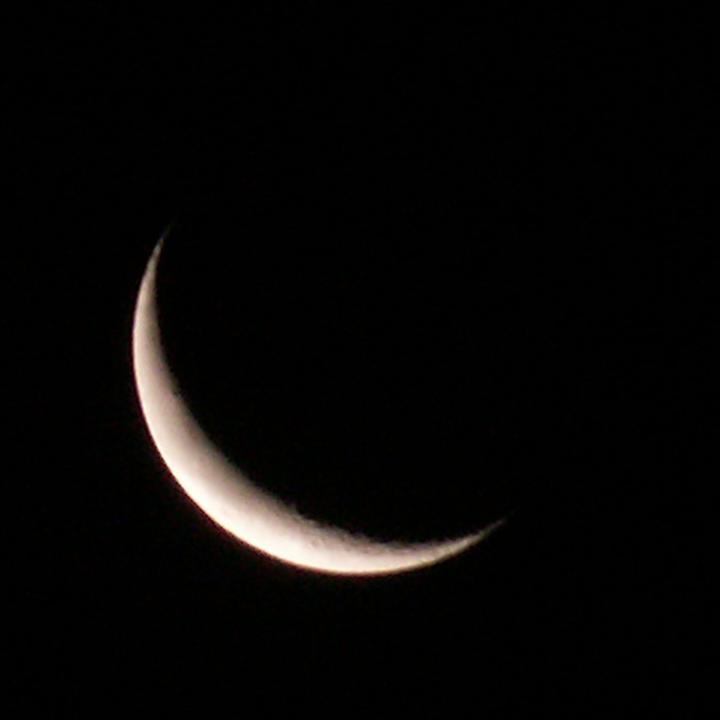
By overexposing the crescent I was able to capture earthshine.
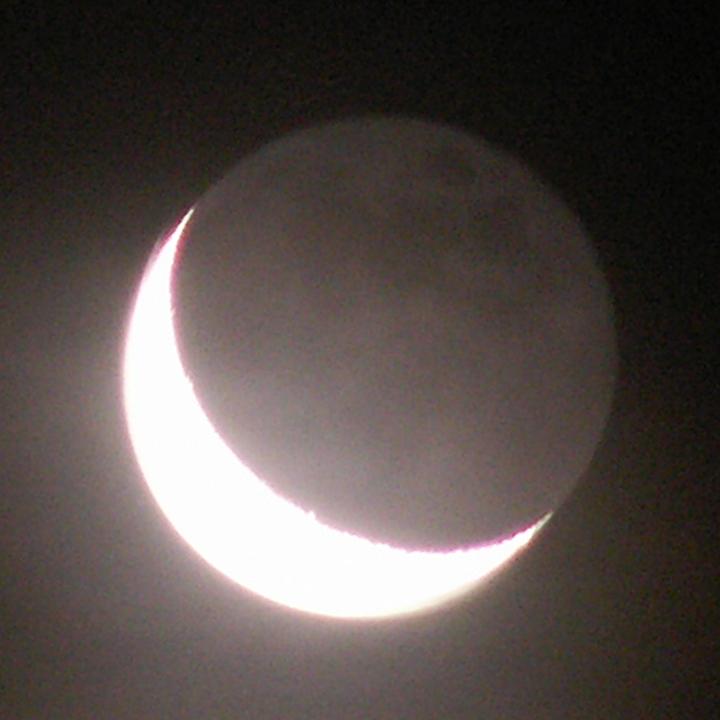
In earthshine, the moon reflects light from two different sources. The thin crescent is light reflected from the sun. But the larger, dimmer illumination, in which one can see some hint of the mares ("seas"), is reflected from the Earth, which itself is reflecting sunlight onto the moon. Hence the term "earthshine". That dimmer illuminated part of the moon is doubly-reflected light.
An artificial satellite was headed in the natural satellite's general direction. Based on info at Heavens Above it was probably the OAO 2 Rocket. OAO 2, the first successful orbiting astronomical observatory, was launched on December 7, 1968.
According to Wikipedia, OAO 2 "carried 11 ultraviolet telescopes. It observed successfully until January 1973, and contributed to many significant astronomical discoveries. Among these were the discovery that comets are surrounded by enormous haloes of hydrogen, several hundred thousand kilometres across, and observations of novae which found that their UV brightness often increased during the decline in their optical brightness."
Our post office walk last night had us heading home after dark. Mary and I swung past the post office pond, where barking frogs and green treefrogs (heard here) were in splendid voice. We listened to them as we stargazed.
The first artificial satellite cut right across the pincers of Scorpius, which made identification easy: the Cosmos 2237 Rocket, launched by Russia on March 26, 1993.
According to Russian Space Web, Cosmos 2237 carried a Tselina-2 electronic intelligence satellite. The Tselina program dates back to the 1970s and is ongoing: "According to reliable sources, during the visit of the Russian president Vladimir Putin to Ukraine in January 2001, two sides agreed to proceed with the plans of launching a pair of Tselina-2 satellites for Russia's Armed Forces. Both spacecraft were apparently in the state of assembly at the time of the agreement."
Shortly thereafter we tracked the Aureole 2 Rocket, launched on December 26, 1973. A joint project of France and what was then the Soviet Union, Aureole 2 (also called Oreol-2) studied energy transport from the Sun to the Earth. (Source: The Ultimax Group, Inc.)
Jupiter hung high overhead as we walked home. A shadow -- most likely a bat -- flitted across our path at eye level as we passed a small park, listening to regularly-spaced, high-pitched peeps (heard here) from high up in a tree. Whether bat or bird, we don't know, though we suspect it was a bat.
"The survival of the human race depends on its ability to find new homes elsewhere in the universe because there's an increasing risk that a disaster will destroy the Earth, world-renowned scientist Stephen Hawking said Tuesday." Associated Press, June 14, 2006, as presented by MSNBC. "He added that if humans can avoid killing themselves in the next 100 years, they should have space settlements that can continue without support from Earth."
Said Hawking, speaking in Hong Kong, "Life on Earth is at the ever-increasing risk of being wiped out by a disaster, such as sudden global warming, nuclear war, a genetically engineered virus or other dangers we have not yet thought of."
I thought of Ray Bradbury's novel Fahrenheit 451 -- but where Bradbury wrote of committing books to memory, of individuals becoming the texts in essence and identity, I think of place. Not a country, or a city. Perhaps not even a square block. Nothing that falls into a tidy unit. Or into a tidy species, separated out from the rest of its environment.
How does one capture and preserve the memory of a melange of life -- so many creatures and phenomena impinging on so many senses, even within our limited, human-centered perception? As I watch and listen to today's avian dinosaurs (see "Magic Pond #2 and More") I know that, in the end, we can only guess what their Mesozoic ancestry was like from the traces left behind. Did their ancestors roar, or did they warble? Did they sound like something else entirely? Now that ancient feathered dinosaurs have entered the realm of the possible, what color might their plumage have been? What was that world really like?
No matter how close we come from studying the evidence, we have no way to tell. All we have is the barest outline. The rest is left to our imagination, extrapolating from paltry cues.
I grew up aching to travel into space. Star Trek defined not only my popular culture but my spirituality; the Trek adventures I wrote as a kid evolved into the science fiction I write now -- yet that science fiction is either Earth-based or set in an environment very similar to Earth's.
In the 1970s a NASA publication called Spinoffs detailed the thousands of patents, born of space exploration, that directly benefited life on this planet. The seismic detector technology of early lunar probes found its way into meat tenderometers used by the USDA to gauge food quality. ECHO weather balloon mylar found new application in "Magic Mirror" wallpaper designed to save on heating and cooling costs. The Golden Canopy, a special bed for burn victims, took its cue from astronaut faceplates, in which gold strands conducted heat to keep astronauts' faces from freezing in the cold of space. On Earth, the temperature-controllable canopy replaced a primitive and inefficient setup of blankets draped over hoops.
I came across that information 30 years ago -- at a time when Americans spent more money on cosmetics than on NASA's entire budget. I have no idea how the numbers compare today.
My childhood dream has transformed over time. My space travel -- "to explore strange new worlds, to seek out new life and new civilizations" -- goes forward at warp speed, all within a mile of home. Distance is replaced by depth, even as I realize that I only scratch the surface. I remain a tourist in my own back yard.
But one thing is clear. Regardless of how much Earth is at risk from cataclysm (and it wouldn't be the first time), and the potential necessity of Hawkings' message, I believe we can't ever come close to conceiving of all that we would lose by leaving it behind.











1 Comments:
I admire your ability to take such close-up shots and zoooom into the moon like that!
Post a Comment
<< Home